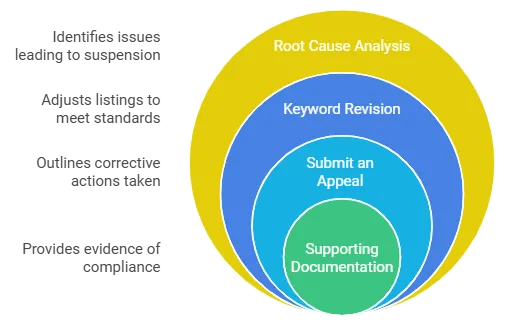How to Avoid Price Gouging Violations on Amazon
How to Avoid Price Gouging Violations on Amazon
In recent years, price gouging has become a significant concern for online marketplaces like Amazon. During times of crisis or high demand, some sellers may raise prices excessively to capitalize on increased consumer needs. However, this practice can lead to severe consequences, including listing removal, account suspension, or even deactivation. Amazon enforces strict guidelines to prevent price gouging, aiming to maintain trust with its customers.
In this article, we’ll explore what constitutes price gouging on Amazon, why it’s a critical issue, and how sellers can avoid such violations. We’ll also discuss strategies for handling reinstatement if your account is suspended due to price gouging complaints.
What is Price Gouging on Amazon?
Price gouging refers to the practice of drastically increasing the prices of essential products beyond a reasonable threshold, often in response to an emergency or a sudden surge in demand. Amazon monitors pricing closely to protect customers from unjust pricing, particularly during crises such as natural disasters, pandemics, or major supply chain disruptions.
Example: If a seller raises the price of hand sanitizers from $5 to $50 during a health crisis, it would be considered price gouging. Amazon considers price gouging not only a violation of its marketplace guidelines but also as an act that undermines customer trust.
Why Price Gouging Leads to Account Suspensions
Amazon aims to maintain a fair and reliable marketplace where customers can purchase products at reasonable prices. Price gouging violates this goal and can lead to increased complaints, bad reviews, and legal scrutiny, especially when it involves essential goods like medical supplies, food, or personal protective equipment (PPE).
When Amazon detects or receives complaints about price gouging, it may initiate an investigation into the seller’s account. Depending on the severity of the issue, consequences can include listing removal, account suspension, or permanent deactivation.
Common Causes of Price Gouging Violations
Several factors can lead to expired product violations. Here are the most common causes that lead to suspensions or deactivations:
1. Dynamic Pricing Errors
Some sellers use dynamic pricing algorithms to adjust their prices automatically. However, during times of increased demand, these algorithms can unintentionally lead to steep price hikes. If not closely monitored, these systems can result in violations.
2. Inaccurate Competitor Benchmarking
Sellers often base their prices on competitor listings. However, in times of crisis, using inflated competitor prices as a benchmark without understanding Amazon’s guidelines can lead to price gouging violations.
3. Failure to Respond to Market Changes
During emergencies, Amazon imposes strict pricing caps to prevent price gouging. Sellers who fail to adjust their pricing strategies in response to these market changes may inadvertently violate Amazon’s policies.
4. Lack of Clear Pricing Policies
Sellers without clear pricing policies or manual oversight can inadvertently allow prices to escalate during high-demand periods. For example, if a seller allows prices to fluctuate without guidelines or checks, it can lead to unintentional price gouging.
How to Avoid Price Gouging Violations on Amazon
To protect your listing from suspensions or deactivations, it’s essential to adhere to Amazon’s guidelines and take proactive steps to prevent expired product complaints. Here are some strategies to stay compliant:
1. Monitor Pricing Closely During High-Demand Periods
Pay close attention to market trends and pricing caps imposed by Amazon during emergencies or crises. Adjust your pricing strategies to align with Amazon’s guidelines.
2. Use Manual Overrides for Dynamic Pricing Algorithms
Implement manual checks and overrides to ensure that your dynamic pricing algorithms do not lead to unintentional price hikes. Review and test these systems regularly to avoid violations.
3. Establish Clear Pricing Policies
Develop and enforce clear pricing policies that outline maximum allowable price increases during times of increased demand. This will help you maintain compliance and protect your account.
4. Benchmark Prices Responsibly
Avoid relying solely on competitor listings for benchmarking. Ensure that your prices are competitive but reasonable within Amazon’s guidelines, especially for essential products.
What to Do If Your Account is Suspended for Price Gouging Violations
What to Do If Your Account is Suspended for Price Gouging Violations
If your Amazon account is suspended or deactivated due to price gouging complaints, taking prompt action is essential to resolve the issue. Here’s a step-by-step guide for handling reinstatement:

Example: A seller who faced suspension for price gouging during a pandemic successfully reinstated their account by implementing manual pricing checks, enforcing stricter pricing caps, and submitting a well-documented appeal. Their account was reinstated within a few weeks after demonstrating compliance.
Frequently Asked Questions (FAQ)
Frequently Asked Questions
Frequently Asked Questions
Yes, repeated or severe violations—such as consistently inflating prices during crises—can lead to permanent account deactivation. To avoid this, strictly follow Amazon’s pricing guidelines and adjust your strategy during high-demand periods.
The timeline for reinstatement depends on the severity of the violation and the thoroughness of your appeal. Minor issues may be resolved within a few days, while more complex problems could take several weeks.
If your appeal is rejected, carefully review Amazon’s feedback and address any unresolved issues. Submit a revised appeal with additional corrective measures or documentation to strengthen your case for reinstatement.
Protecting Your Amazon Business from Price Gouging Violations
Price gouging can have severe consequences for your Amazon business, including listing removal, account suspension, or permanent deactivation. Sellers must stay vigilant, especially during emergencies or high-demand periods, and ensure their pricing strategies align with Amazon’s guidelines to protect their business and customers.
If your account has been suspended due to price gouging complaints, taking prompt and well-documented action is essential to reinstatement. At Amazon Sellers Appeal by ASA Compliance Group, led by Or Shamosh, we specialize in helping sellers navigate Amazon’s complex compliance landscape and offer expert support for reinstatement. [Contact us today] to fast-track your account’s reinstatement and keep your business running smoothly.









